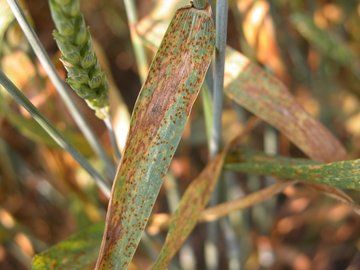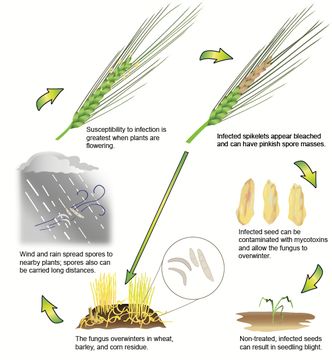
Get a First Look 🔍: “A Diagnostic Guide of Diseases Caused by Diaporthe Species in Soybean,” by Milsha George et al.: https://doi.org/10.1094/PHP-03-25-0096-DG
06.11.2025 15:24 — 👍 0 🔁 0 💬 0 📌 0@planthealthprog.bsky.social
A peer-reviewed, multidisciplinary journal of applied plant health and crop protection. Published by The American Phytopathological Society.

Get a First Look 🔍: “A Diagnostic Guide of Diseases Caused by Diaporthe Species in Soybean,” by Milsha George et al.: https://doi.org/10.1094/PHP-03-25-0096-DG
06.11.2025 15:24 — 👍 0 🔁 0 💬 0 📌 0
FIGURE 1 States in which tomato high tunnel soil samples were obtained for soilborne disease survey in four survey years.
High tunnels protect plants, but conditions often result in the accumulation of soilborne pathogens in tomato. Manisha Hamal et al. evaluated the prevalence of soilborne pathogens in 265 tomato high tunnels on 118 farms from 12 states: https://doi.org/10.1094/PHP-01-25-0004-S
03.11.2025 16:55 — 👍 1 🔁 1 💬 1 📌 0
Get a First Look 🔍: “Genome-Wide Association Study Identified One Major Quantitative Trait Locus Associated with Resistance to Fusarium proliferatum in Soybean (Glycine max L.),” by Nitha Rafi, Matias Dominguez, and Febina M. Mathew
28.10.2025 17:10 — 👍 0 🔁 0 💬 0 📌 0
FIGURE 5 Symptoms and signs of downy mildew affecting Lenten rose caused by Peronospora pulveracea. A and B, Diseased leaves displaying dark brown-to-black speckled lesions on adaxial leaf surfaces. C and D, White-to-brown floccose mycelial growth on the abaxial leaf surface. E, Sporangiophores emerging through stomata on the abaxial leaf surface. F, Sporangiophore. G, Close-up image of sporangiophore ramifications showing sporangia developing and ultimate branchlets. H, Sporangia. I, Oospore. Scale bars: C = 5 mm; D = 500 µm; E to G = 50 μm; H and I = 20 µm.
Where flowers bloom, so do downy mildews: Catalina Salgado-Salazar et al. report downy mildew observations on several annual, herbaceous perennial, and woody shrub plants in several states in the eastern United States. https://doi.org/10.1094/PHP-10-24-0100-RS
22.10.2025 20:07 — 👍 1 🔁 0 💬 0 📌 0
On this #WorldFoodDay, we celebrate the efforts of those who nourish our communities, protect our planet, and shape a better future through better food for all. Explore resources to learn more about food security and sustainability. #FAO80
https://bit.ly/4nqN3x7

FIGURE 4 USVL608-PMR showing intermediate resistance to powdery mildew isolate 677X608. However, USVL608-PMR was significantly (P = 0.05) less susceptible than USVL677-PMS to all the isolates evaluated in this study.
Physiological races of Podosphaera xanthii have not been classified for watermelon. Chandrasekar S. Kousik and Jennifer L. Ikerd developed a set of watermelon powdery mildew race differentials and identified potential races. 🍉 https://doi.org/10.1094/PHP-11-24-0114-RS
13.10.2025 16:52 — 👍 0 🔁 0 💬 0 📌 0
Plant Disease Management Reports (PDMRs) are now easier to navigate! A new update allows users to filter PDMRs by crop type and author, making it easier than ever to find relevant reports.
Explore PDMRs published in Plant Health Progress: apsjournals.apsnet.org/topic/pdmrar...

Get a First Look 🔍: “Field-Scale Evaluation of Fungicide Timing for Corn Diseases and Yield in Indiana from 2019 to 2022,” by Kaitlin G. Waibel et al.: https://doi.org/10.1094/PHP-04-25-0103-RS @DTelenko
07.10.2025 16:50 — 👍 0 🔁 0 💬 0 📌 0
FIGURE 1 Symptoms caused by a mixed infection of cucurbit yellow stunting disorder virus (Crinivirus cucurbitae) and watermelon chlorotic stunt virus (Begomovirus citrulli) in watermelon plants: A and B, stunting; C to E, chlorotic mottling; and F, yellowing.
Since 2020, a disease syndrome on watermelon plants has been observed in Jalisco, Mexico. Hernández-Pérez et al. present the first report of CYSDV and WmCSV in a natural mixed infection in watermelon in Mexico 🍉: https://doi.org/10.1094/PHP-10-24-0096-BR
01.10.2025 19:45 — 👍 0 🔁 0 💬 1 📌 0Get a First Look 🔍: “Comparison of Cuprous Oxide and Chlorothalonil Applied Alone and as Tank Mix Partners with Flutolanil or Inpyrfluxam for Management of Late Leaf Spot (Nothopassalora personata) of Peanut,” by Alana G. Atkinson et al.: https://doi.org/10.1094/PHP-02-25-0052-RS
25.09.2025 16:53 — 👍 0 🔁 0 💬 0 📌 0
FIGURE 1 Early symptoms of Botrytis head rot after insect damage.
Diagnostic Guide: “Sunflower Head Rot Diseases: Botrytis Head Rot and Bacterial Head Rot,” by Malcolm Ryley et al.: https://doi.org/10.1094/PHP-08-24-0077-DG
22.09.2025 17:09 — 👍 0 🔁 0 💬 0 📌 0Get a First Look 🔍: “Occurrence of Plant-Parasitic Nematodes in Pacific Northwest Hopyards,” by Lester Antonio Núñez Rodríguez et al.: https://doi.org/10.1094/PHP-01-25-0011-RS
18.09.2025 21:30 — 👍 1 🔁 1 💬 0 📌 0
Examples of tuber and foliar symptoms observed in Potato virus Y (PVY)-positive diagnostic samples received from Michigan seed and commercial production. Prevalent strains detected include PVYN-Wi and PVYNTN, and strain results are shown above or below the external, internal, and/or leaf symptoms shown in each column. Tuber examples include public and proprietary chipping and yellow-fleshed varieties; foliar symptoms are shown in a russet variety. Using methods by Mumford et al. (2000), diagnostic samples tested negative for Potato mop top virus (PMTV) and Tobacco rattle virus (TRV).
Potato virus Y (PVY) strain surveys (2019–2023) across Michigan seed lots by Mio Satoh-Cruz et al. reveal PVYN-Wi as dominant, but necrotic strains like PVYNTN and PVYE persist. Continued monitoring is vital for management. Learn more: doi.org/10.1094/PHP-...
19.05.2025 19:32 — 👍 0 🔁 0 💬 0 📌 0
Symptoms of aerial stem rot (ASR) caused by Pectobacterium carotovorum. A, Initial infections occur through wounds such as petiole scars or insect damage and expand outward, creating a distinct black lesion. B, The lesion spreads down the stem, infecting petioles and eventually killing the stem. C, Severe ASR infection showing disease in four out of five stems on the plant. Note that the lesions have spread down the stem as healthy, green tissue can be seen around the base of the plant in the infected stems.
A decade-long study by Phillip S. Wharton, Alan Malek, and Katie L. Malek, published in Plant Health Progress, is the first to provide conclusive evidence that copper-based fungicides reliably manage aerial stem rot in potatoes. 🥔 Read the full press release: www.apsnet.org/about/newsro...
17.04.2025 17:37 — 👍 4 🔁 1 💬 0 📌 0
Wheat leaf with rust spores and dead tissue.

Illustration of disease cycle of Fusarium head blight.
560 million bushels gone. $2.9 billion lost.
These are the estimated losses caused by wheat diseases from 2018 to 2021. Read more in the new @planthealthprog.bsky.social publication at doi.org/10.1094/PHP-....
@badgercropdoc.bsky.social @alabamaed1.bsky.social
#science 🧪 #wheat #disease #IPM

A 3-year study by Bhavit Chhabra et al. in the eastern U.S. showed that the fungicide Sphaerex effectively controlled Fusarium head blight and deoxynivalenol levels, with similar results to standard fungicides. @umnplantpath.bsky.social doi.org/10.1094/PHP-...
25.02.2025 17:35 — 👍 0 🔁 1 💬 0 📌 0Starting this year, Plant Disease Management Reports (PDMRs) will be published in Plant Health Progress. With this change, PDMRs now offer year-round submission with prompt publication upon acceptance. Learn more: apsjournals.apsnet.org/page/php/pdmr
24.02.2025 16:57 — 👍 0 🔁 0 💬 0 📌 0
Three-week-old cultures of Berkeleyomyces rouxiae on potato dextrose agar (PDA) showed some degrees of morphological variation: A, dark pigmented colony with some exudate droplets on the surface; B, colony with albino sectors developed as a result of serial subculturing; and C, hyaline to subhyaline rod-shaped endoconidia and club-shaped dark pigmented chlamydospores that are chains of singular cells.
Black root rot is a significant seedling disease in Australian cotton. This guide by Duy P. Le et al. offers diagnostic tools, pathogen isolation methods, molecular identification techniques, and pathogenicity assessment approaches. doi.org/10.1094/PHP-...
17.02.2025 19:57 — 👍 0 🔁 0 💬 0 📌 0
Symptoms of Cercospora leaf spot caused by the fungus Cercospora beticola begin as A, small spots with a gray center and B, rapidly coalesce to encompass the leaf, resulting in defoliation.
Foliar diseases affect table beet production in New York. Field trials by Pratibha Sharma et al. show varying susceptibility among cultivars, with Bazzu and Irazu offering the best resistance to all three diseases. doi.org/10.1094/PHP-...
11.02.2025 18:07 — 👍 2 🔁 0 💬 0 📌 0Thank you for this recognition @planthealthprog.bsky.social @plantdisease.bsky.social! 🎊🥳
05.02.2025 23:06 — 👍 2 🔁 1 💬 0 📌 0
Symptoms observed in small fruits and grapevines infected with tomato ringspot virus (ToRSV). A, Shortening internodes and decline on wine grape; B, ringspots on blueberry; C, vein clearing on red raspberry; and D, mosaic on red currant.
Small fruit crops are vital to the Pacific Northwest. A new study by Cristian Olaya et al. reveals dagger nematodes in 52% of fields surveyed and reports ToRSV in Oregon wine grapes and red currants for the first time, updating virus-vector data. Learn more: doi.org/10.1094/PHP-...
07.01.2025 19:46 — 👍 1 🔁 0 💬 0 📌 0"The...significant effect of hybrid susceptibility on disease severity & yield suggests...use of genetic resistance may be more effective in tar spot...management than altering plant density."
From @planthealthprog.bsky.social's pub apsjournals.apsnet.org/doi/10.1094/...
@plantdisease.bsky.social

The reniform nematode is a major yield-limiting pest in tropical and subtropical crops. This updated map from Travis R. Faske et al. shows its county-level distribution in U.S. field crops, aiding targeted management. doi.org/10.1094/PHP-... @mahduffeck.bsky.social
19.12.2024 20:08 — 👍 1 🔁 0 💬 0 📌 0